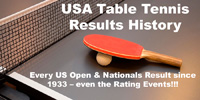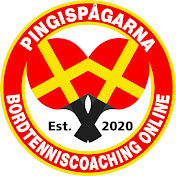April 7, 2014 - Attacking the Middle
The middle is the weakest spot for most players. When I say middle, I don't mean the middle of the table; it's the mid-point between the opponent's forehand and backhand, usually where the playing elbow is. Most beginning players play to the opponent's forehand or backhand, while most intermediate players play wider angles. Advanced players know that while angled attacks are good, the best place for the first attack (and often follow-up attacks) is right at the middle.
Why is the middle so weak when attacked? There are five (yes, five!) primary reasons.
- The player has to make a decision on whether to play forehand or backhand, and often hesitates. When the ball goes to the forehand or backhand there is no such decision to make.
- The player has to move in an uncomfortable direction. Most players find moving wide to cover the forehand or backhand an easier move since you are moving into the shot. Covering the middle means essentially getting out of the way of the ball, which is usually a more difficult move.
- When you attack the middle, it forces your opponent to move out of position to cover it. This opens up the corners. One of the best one-two combos is an attack to the middle followed by an angled attack. Or you can go to the middle a second or third time as your opponent struggles to cover it.
- Attacking the middle takes away the extreme angles for your opponent. If you attack a wide corner, your opponent can return at an equally wide angle.
- Players don't get much practice covering the middle, both because opponents don't give them this shot much until the higher levels, and because most don't practice against it. (Here are three Tips on covering the middle: Covering the Middle; Covering and Recovering From the Middle; and Covering the Middle with the Forehand.)
Attacking the middle isn't just an option; it should be the default place to attack unless you have a reason to go elsewhere, such as an open corner, a slow opponent who doesn't cover the corners well, or an opponent who is weaker on one side. The nice thing about attacking the middle is that even if the opponent knows it's coming he can't really prepare for it. If he tries to favor one side to cover it, you simply move your target over to compensate.
While you should usually be aggressive when going to the middle, there are at least two other times you might go to the middle with a less aggressive shot. First, against a two-winged attacker, you might serve or push deep to the middle to make him decide whether to forehand or backhand attack and then move to do so. Second, going to the middle cuts off the angles, so a passive shot can't be attacked at a wide angle. (But a smart opponent might instead attack your middle!)
Why don't players attack the middle more often? There are two primary reasons. First, it's difficult to hit because it's a moving target. When you attack the wide forehand or wide backhand, it's the same place no matter who you play. But the middle changes not only from player to player but throughout the rally against the same opponent, depending on where he is standing or looking to do. (An example of the latter is if the opponent is looking to attack with his forehand, then going to his middle only gives him an easier forehand, so his "middle" moves toward his backhand side.) The only way to develop the ability to attack this moving target is by doing it over and over in matches and drills until it becomes second nature. And this leads to the second reason players don't attack the middle more often: because they don't practice attacking the middle.
Most players practice their attacks either crosscourt or down the line to their partner's block, and so they go to the partner's forehand or backhand, over and over. This becomes a habit. If all one does is attack to the forehand or backhand in practice, how likely is the player going to go to the middle in a match? You have to practice it if you want to do it in a match. Here are some drills you can do to practice attacking the middle.
- Attack the Middle Drill. Have your practice partner stand in a neutral position so you can see where his middle is. Then drill into that spot, either looping or hitting. Your practice partner blocks moves over and blocks, either all forehand or all backhand. However, there are two variations to this. You partner can also block with either all backhand or forehand, but moves back to a neutral position after each shot, so he can practice moving to cover the middle. A third way, the most difficult, is he stands in a neutral position and blocks back either forehand or backhand.
- Serve and Attack Middle Drill. You serve backspin, your partner pushes back (either to a pre-arranged spot or random), and you attack his middle. Then play out the point.
- Practice Matches. Play practice matches where your first attack goes to the middle every time.
So learn to attack the middle, and soon you'll leave the middle of the pack as you move up the ladder of table tennis success!





